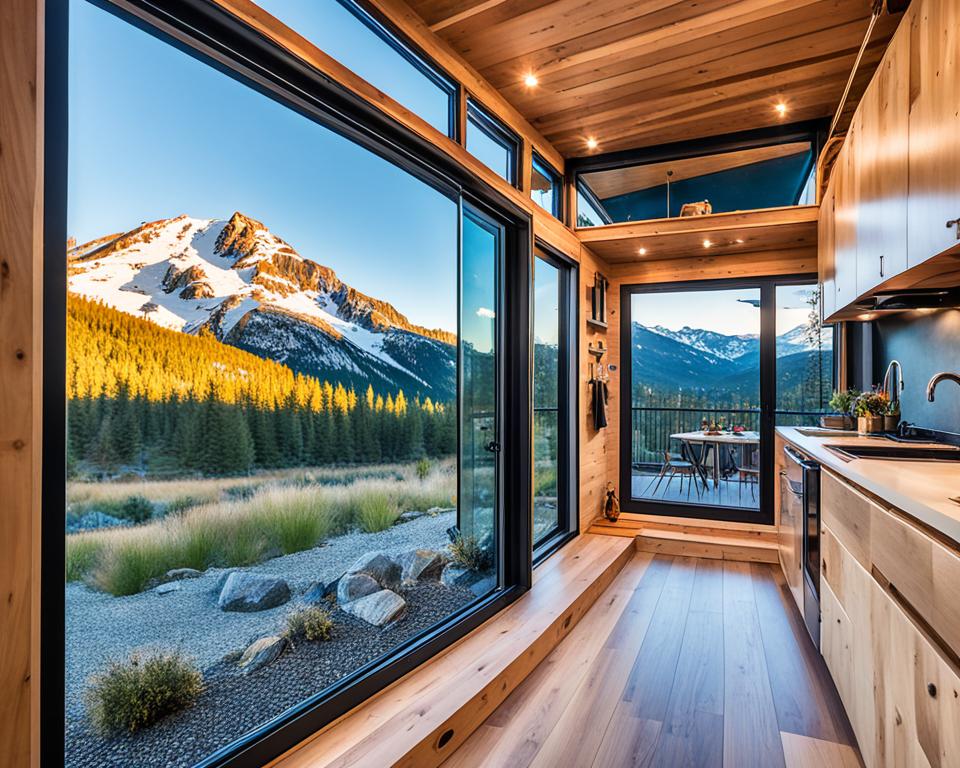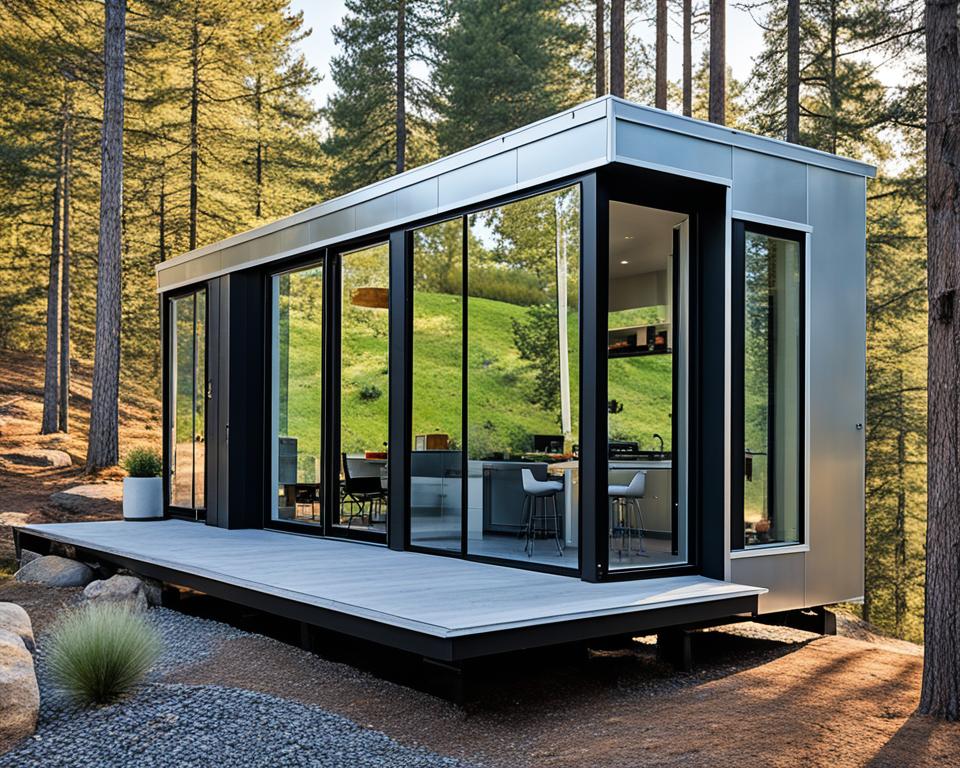Did you know the average tiny house is just 225 square feet? Despite their small size, these compact homes are popular for those wanting a simpler life. Glass is key in making a tiny home stylish and functional. The right glass can make the space seem larger and more welcoming.
Glass is crucial in tiny home design, offering a connection to the outdoors. It provides dwellers with beautiful views and natural light. Choosing the right glass for windows ensures the house stays both energy-efficient and private.
This article will dive into tiny house glass, exploring its many benefits. We’ll look at pragmatic advice for selecting glass for your small home and share creative design and global examples. We’ll also tackle privacy and transparency issues, offering glazing maintenance tips.
The Benefits of Glass in Tiny House Design
Glass plays a crucial role in enhancing the design of a tiny home. It ushers in natural light and makes the living area feel more spacious. The careful use of glass can turn a small, enclosed space into a bright and welcoming environment.
Maximizing Natural Light
Glass’s main draw for tiny homes is its ability to invite in natural light. This feature significantly reduces the need for artificial light within the space. By letting the sun permeate through, it creates a warm and inviting atmosphere. Such brightness can positively affect the mood and health of those living in the tiny house.
Creating a Sense of Spaciousness
Glass also gives the illusion of more space in a tiny home. It blurs the boundary between the indoor and outdoor areas. Choosing floor-to-ceiling windows or glass walls expands the apparent size of the living space. It merges the home with its environment, making it feel larger and more open than its actual dimensions.
“Glass is a game-changer in tiny house design. It allows us to bring the outdoors in, making the space feel more open and connected to nature.” – Sarah Thompson, Tiny House Enthusiast
Enhancing Energy Efficiency
Furthermore, glass can help improve the energy efficiency of a tiny home. Selecting the right glass types like double-paned or low-E can keep the home’s temperature stable. This choice reduces the need for excessive heating or cooling. The outcome is a more eco-friendly space that is both cost-effective and comfortable.
| Glass Type | Benefits |
|---|---|
| Double-paned glass | Provides excellent insulation, reducing heat transfer and improving energy efficiency |
| Low-E glass | Reflects heat back into the room during winter and minimizes heat gain during summer |
| Tempered glass | Offers increased strength and safety, shattering into small, less dangerous pieces if broken |
By leveraging the strengths of glass, tiny house owners can achieve both beauty and functionality. The use of glass enables the residents to experience abundant natural light, a sense of openness, and comfortable living conditions. It marries efficiently with the simple and charming lifestyle that compact living offers.
Choosing the Right Glass for Your Tiny Home

The choice of glass for your tiny house involves several critical considerations. Various glass types offer distinct benefits and features. In selecting the right one, think about energy efficiency, safety, and fitting the climate. This helps you design a cozy and visually appealing home that suits your needs.
Types of Glass for Tiny Houses
There are several glass options suitable for tiny homes, each with unique pros. Notable choices include:
- Tempered glass undergoes a strengthening heat process, ensuring if it breaks, it forms safe, small pieces. This is ideal for safety in tiny living spaces.
- Laminated glass consists of glass layers bound by a plastic interlayer, offering better safety and sound reduction. It’s a great option for windows in tiny homes.
- Double-paned glass, or insulated glass, boasts two layers with a sealed space in between. It excels in thermal insulation and energy conservation, vital for comfort in compact living spaces.
Factors to Consider When Selecting Glass
In choosing glass, keep these factors in mind:
- Local climate: Pick glass suitable for your area’s weather extremes, ensuring its durability.
- Energy efficiency: Choose glass that’s energy-saving, like double-paned or low-E glass, reducing your home’s energy use.
- Privacy needs: Assess your privacy needs and select glass that strikes the right balance between light and seclusion.
- Design aesthetic: Opt for glass that enhances your home’s style, be it modern, rustic, or minimalist.
- Window orientation: Consider sun exposure and how it affects the comfort of your small living space.
By evaluating these factors, you can make a smart choice in glass, crafting a functional and appealing living area that caters to your preferences.
| Glass Type | Key Benefits | Ideal Applications |
|---|---|---|
| Tempered Glass | Enhanced safety, increased strength and durability | Windows, doors, shower enclosures |
| Laminated Glass | Improved safety, sound insulation, UV protection | Windows, skylights, partitions |
| Double-Paned Glass | Excellent thermal insulation, energy efficiency, noise reduction | Windows, doors, skylights |
“Selecting the right glass for your tiny home is a crucial decision that can significantly impact the comfort, efficiency, and overall aesthetic of your living space.” – Sarah Thompson, Tiny House Design Expert
Thoroughly analyzing glass types and considering crucial aspects like safety, energy efficiency, and climate suitability helps in making a choice that improves your tiny living experience.
Creative Ways to Incorporate Glass in Tiny Houses

Innovative glass design for tiny homes opens up a world of possibilities. From simple applications to transformative features, glass can change the dynamics of compact living. We’ll look into glass uses that enhance both function and style in small living spaces.
Using glass as a room divider is a top choice for saving space in tiny homes. These partitions maintain an airy feel while sectioning off areas. They allow light to travel, keeping the space bright and connected. This setup combines privacy with an open layout, forming a harmonious design throughout.
Skylights and clerestory windows are another clever glass addition for tiny houses. Placed strategically, they bring natural light deep into the home. They not only brighten up dim areas but also frame outdoor views. This design trick adds a feeling of openness and connects the interior with nature.
Glass features can be multifunctional, revolutionizing tiny house living. Let’s consider a few standout examples:
| Multipurpose Glass Element | Description |
|---|---|
| Glass-topped dining table | This table acts as both dining and work space, saving room and adding style. |
| Glass-enclosed shower | A see-through shower makes the bathroom appear larger and more luxurious. |
| Glass staircase | A clear staircase maintains a spacious feel and adds a unique visual touch. |
| Glass cabinet doors | Transparent cabinet doors display items and keep the room looking open. |
Thinking creatively about glass usage in small homes can lead to exceptional results. It merges practicality with elegance, enriching the living experience. These applications elevate the beauty and functionality of compact spaces.
Glass in tiny houses blurs indoor and outdoor boundaries, fostering a natural and elegant connection.
Exploring the breadth of glass design inspires novel concepts for small living. With a focus on inventive yet practical applications, we can truly personalize our tiny homes. The result is a space that meets our specific needs and embodies our individual flair.
Tiny House Glass: Balancing Privacy and Openness
In the design of a tiny house, the quest for the perfect mix of seclusion and openness is key. Glass is instrumental in this effort. It floods the dwelling with sunlight but also offers a sense of privacy. Through smart selection and use of privacy glass solutions, we can make any space comfortable and adaptable. This is vital for our ever-evolving needs.
Privacy Solutions for Glass in Tiny Homes
The go-to for privacy in tiny houses often is frosted or textured glass. This glass type lets light in but keeps the view outside blurred, perfect for areas needing seclusion, like washrooms. Frosted glass works wonders in maintaining a sense of privacy without blocking natural light. It cocoons the space, adding an intimate touch.
For those looking for a modern twist, switchable glass is a game-changer. With a flick of a switch, it turns from clear to opaque, offering instant privacy. The smart glass choice means no need for the usual drapes or shades. It’s a clever space-saving option for tiny houses.
Striking the Perfect Balance
Sometimes, the classic approach with curtains or blinds is still the best. In a small home, choose ones that are light and compact. They should be effortless to move and stow away. A mix of privacy glass and these light window coverings ensures flexibility. It’s all about personalizing the space to meet our unique lifestyle changes.
| Privacy Solution | Benefits | Ideal Placement |
|---|---|---|
| Frosted Glass | Allows light to pass through while obscuring visibility | Bathrooms, bedrooms, partitions |
| Switchable Glass | Transitions from transparent to opaque instantly | Windows, doors, partitions |
| Curtains and Blinds | Lightweight, space-saving, and easily adjustable | Windows, glass doors |
By carefully blending various privacy solutions and locating glass features thoughtfully, we craft living spaces that are both cozy and welcoming. It’s about enjoying nature’s light while having the option for privacy. This dual approach results in a space that supports our well-being and daily enjoyment.
Maintenance and Care for Tiny House Glass
Keeping the glass elements in your tiny house in top shape is vital. Regular upkeep ensures they’re not only beautiful but also help your home stay bright and energy-efficient. This involves frequent window cleaning and caring for glass throughout your living space.
Cleaning and Upkeep Tips
For sparkling glass surfaces in your tiny home, use these easy tips:
- Use a soft, lint-free cloth or sponge to prevent scratches.
- Opt for a gentle, glass-specific cleaning solution.
- Clean your glass surfaces often to avoid dirt buildup.
- Steer clear of strong chemicals or rough materials that could harm the glass.
- Remember to clean the frames and sills around windows and other glass areas.
Preventing Damage and Wear
Taking steps to avoid glass damage is as important as regular cleaning. Here’s how to protect your windows and other glass surfaces:
- Put felt pads or bumpers on furniture and decorations near glass, in tight living spaces.
- Consider adding a protective film to your glass to prevent glare and damage.
- Be careful where you place furniture and decorations to prevent glass breakage.
- Regularly check glass for wear and tear, fixing any issues quickly.
Following these guidelines will help your tiny house glass last longer and stay beautiful. By investing time in maintenance, your space will not only look better, but it will also be more efficient and comfortable.
“The key to maintaining the beauty and functionality of your tiny house glass is a combination of regular cleaning, proactive protection, and mindful use of the space.”
It’s easy to forget that glass is both an aesthetic and functional part of your tiny home. With proper care, you can magnify the positive impact it has on your living space. This results in a home that’s not only brighter and more beautiful but also more comfortable.
Inspiring Tiny House Glass Designs from Around the World
Tiny house enthusiasts and designers worldwide are continually pushing the boundaries of what’s possible with glass in compact living spaces. They create sleek, modern designs or cozy, rustic cabins. One of the major trends globally is the use of floor-to-ceiling glass walls. These walls enhance the sense of spaciousness and immersion in nature by connecting the interior with the landscape.
In Scandinavian countries, natural light is highly valued. Hence, tiny house designers there maximize daylight by using large windows. They aim to create a bright, airy atmosphere. These designs also usually feature clean, minimalistic lines and a neutral color palette. This allows the beauty of the glass and the outdoor views to be the focal points. Such thoughtful design shows how glass can make small living spaces more livable and visually appealing.
In places like Australia and New Zealand, where the climate is warmer, designers focus on connecting indoor and outdoor spaces. They use sliding glass doors, bifold windows, and retractable glass walls. These features let tiny house dwellers expand their living spaces and enjoy the weather outside. These examples show the versatility and adaptability of glass in different climates and living styles.
By taking inspiration from these global trends, aspiring tiny house owners can craft spaces that are both unique and functional. They can use glass creatively to embrace the beauty of compact living.

